Effect of the Gurgem-7 Traditional Compound on CCL4-Induced Chronic Hepatitis
Author'(s): Hushan1, Chimedragchaa Ch2, Altantsetseg A2 and Tsend-Ayush D1*
1International School of Mongolian Medicine, MNUMS Mongolia.
2Institute of Traditional Medicine and Technology of Mongolia.
*Correspondence:
Damba Tsend-Ayush Professor, MD, Ph.D, Lecturer, Department of Mongolian medicine study, International School of Mongolian Medicine, MNUMS, Zorig street 3, Sukhbaatar district, Ulaanbaatar-14210, Mongolia, E-mail: tsendayush@mnums.edu.mn.
Received: 29 October 2018 Accepted: 20 November 2018
Citation: Hushan, Chimedragchaa Ch, Altantsetseg A, et al. Effect of the Gurgem-7 Traditional Compound On CCL4-Induced Chronic Hepatitis. Gastroint Hepatol Dig Dis. 2018; 1(3): 1-5.
Abstract
It is necessary to investigate wide range, low side effect, and long-term usage plant origin remedy for hepatobiliary disease. The more perspective medication is polycomponent traditional drug [1]. Study was done on investigation of Gurgem-13 polyprescription [2,3] on experimental chronic hepatitis model by Gi-ppeum Lee, Won-IL Jeong (2005) induced by 10%-1.0 mg/kg – CCl4 three times per week on Wistar bread rats, and following studying of remedy curing results in 1, 2, 3 weeks of experiment. Gurgem-13 traditional prescription was compared with Carsil, and Lilicoaguliant - traditional remedy [4]. The result shown Gurgem-13 is more efficient on lowering AST, ALT enzymes in three months of chronic toxic hepatitis (p=0.15) similar with comparative drugs. More results tell us the Gurgem-13 has an antioxidant effect. Traditional compound Gurgem-13 relieving symptoms of cytolysis, liver function failure, and demonstrated antioxidant, hepatoprotective effect, meantime correcting cholestasis and metabolism of iron in the liver.
Keywords
Intorduction
Nowadays instead of using hepatoprotective drugs alone there are many prescriptions of traditional medicine that are mutually supportive based on taste, strength and composition. Although we have been studying each ingredient in the recipe separately, it is also a new approach to study recipe as a complex formulation and to serve with complex medicines with multi-ingredient [5].
The hepatoprotective effect of Gurgem-13 complex has not been studied on the inflamed hepatocellular model yet. Therefore, we selected to study pharmacology of this compound, which has been a traditional medicine to treat various diseases of digestive system including chronic liver inflammation, cirrhosis, structural changes and liver dysfunction.
Aim of the study
To investigate pharmacological activity of Gurgem-13 traditional compound on chronic hepatitis induced experimental animal these purposes are following:
- Identify the effect of Gurgem-13 compound on chronic hepatitis and cirrhosis induced experimental animal liver based on some biochemical and blood test results.
- Study the effect of Gurgem-13 compound on antioxidant systems and iron metabolism of the pathology model with chronic hepatitis and cirrhosis.
Material and methods
To induce pathologic model with chronic hepatitis and cirrhosis, 90 species of Wistar rats were injected with 10% CCl4 at 1.0 mg / kg three times a week. On this experiment 1:10 ratio of Gurgem-13 compound preparation is used, and the effectiveness of the compound is tested within three months. A Carsil and a traditional Lilicoaguliant were chosen as comparing drugs.
Results
According to the I.V.Berezovskaya classification (2003) the hepatotoxic characteristic of Gurgem-13 is relatively low LD50 = 7.08 (6.2–8.0) g/kg and the active dose (I.P.Zapadnyuk, 1983) can be 0.25-0.7 g/kg.
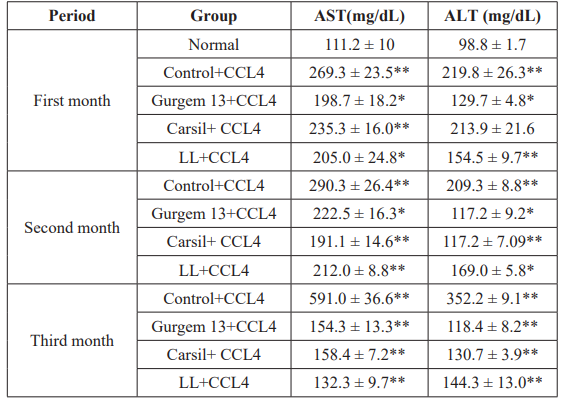
Table 1: The effect of Gurgem-13 compound on hepatic cell breakdown in CCL4 induced chronic hepatitis and cirrhosis. Note: *p=0.05, **p=0.00.
In the first month, the AST level of the control group increased by 2.42 times, in the second month 2.61 times, in the third month 5.3 times, while ALT level increased by 2.2, 2.1 and 3.5 times in 1-3 months respectively (p = 0.00). It shows the intense breakdown of the hepatic cell and quick formation of the pathology model.
In Gurgem-13 group, AST and ALT enzyme level decreased by 26.2% and 41% in the first month, 23.4%, 44% in the second month, 74% and 66.4% in the third month, respectively. It indicated that their inhibiting effect on hepatic cell breakdown.

Table 2: The effect of Gurgem-13 compound on biliary obstruction in CCL4 induced chronic hepatitis and cirrhosis. Note: *p=0.05, **p=0.00.
To detect biliary obstruction in pathology model with chronic hepatitis and cirrhosis, alkaline phosphate enzyme level was measured. In control group, ALP level increased by 29%, 60.6%, and 4.0 times in 1st, 2nd and 3rd month respectively (p = 0.00). In contrast, ALP of Gurgem-13 group decreased by 38.2%, 6.2%, 67.1%, Carsil group by 20.2%, 17%, 70.5%, Lilicoaguliant group by 14.3%, 16.2%, 74.1% shows the effect of compounds on biliary obstruction reduction. (p=0.00)
Moreover, to investigate biliary obstruction in rats with CCL4 induced chronic hepatitis LDH enzyme activity is measured. In control group LDH level increased by 3.7, 2.3 and 2.1 times in 1st,2nd,3rd month (p = 0.00). Comparing control group with Gugrem-13 LDH level of study group decreased by 10.2%, 12.5%, 13%, Carsil by 22.3%, 17.1%, 32.2%, Lilcoaguliant by 48%, 7.7% and 21.1% respectively. (p=0.05). In addition, Gurgem -13 has reducing effect on the bilirubin level by 29.4%, 43%, 12%, Carsil 20.5%, 32% and 27.7%, while Lilicoaguliant 48%, 54.4% and 34.6% (p = 0.00).
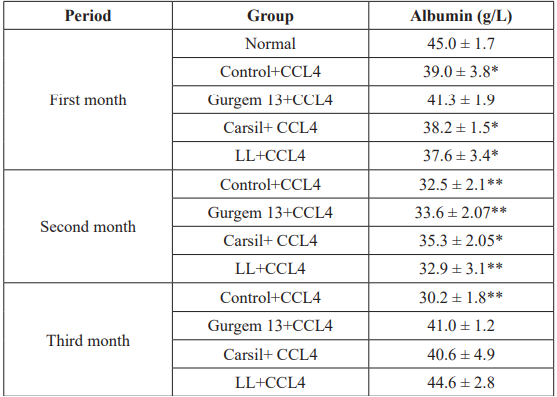
Table 3: The effect of Gurgem-13 compound on cell deficiency in CCL4 induced chronic hepatitis and cirrhosis. Note: *p=0.05, **p=0.00.
Serum albumin of Gurgem-13 group increased by 5.8%, 32% and 27.2% in following three months respectively (p = 0.05). However, in Carsil and Lilicoaguliant groups there were no statistically significant changes in the first two months, although in third month albumin level increased by 34.4%, 48% respectively.
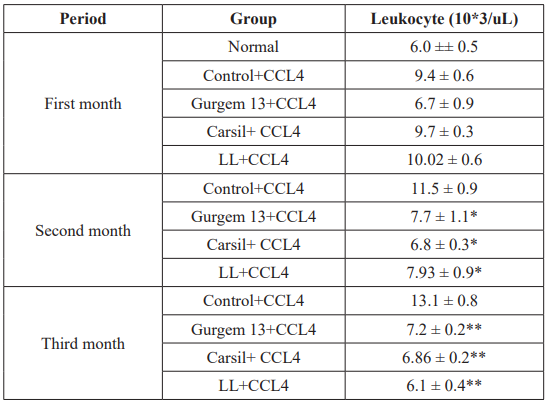
Table 4: The effect of Gurgem-13 compound on blood cell result in CCL4 induced chronic hepatitis and cirrhosis. Note: *p=0.99, **p=0.00.
Number of leukocytes is measured in the blood to determine the process of liver inflammation. The leukocyte count of the control group increased by 56.6%, 86.6% and 2.2 times in comparison with the normal group. In the first month, Gurgem-13 group count decreased by 28.7% and other groups had no statistically significant changes (p = 0.99). Although, in the second month Gurgem-13 group leukocyte count decreased by 33.1%, Carsil group - 41%, Lilycoagulant - 31%, in the third month Gurgem-13 - 45%, Carsil - 48% and Liloicoagulant - 53.4% (p=0.00).

Table 5: The effect of Gurgem-13 compound on superoxide dismutase. Note: *p=0.05, **p=0.00.
As shown in the table 5, in the case of hepatitis in the experimental animals, enzyme in the SOD enzyme decreased as statistically significant, and after using Gurgem-13 the superoxide dismutase (SOD) amount is increased by 4%, 12% and 40% in 1, 2 and 3 months, respectively (p = 0.05). Also, we compared normal group to control group, Gurgem-13 increased by serum SOD 23%, 14.3% and 14.6% in 1, 2 and 3 months (p = 0.05) and Carsil was 21.4%, 37.3% and 13.3%, in the first and third month uses of lilycoagulant reduced serum SOD by 13-18.6%, and in the second month there are no statistically significant differences.
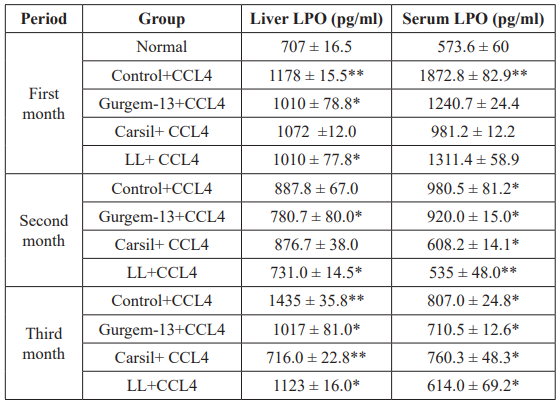
Table 6: The effect of Gurgem-13 on LPO in CCL14 induced chronic hepatitis and cirrhosis. Note: *p=0.05, **p=0.00.
Comparing two groups of LPO level, control group’s LPO has increased in the pathology model. Gurgem-13 reduced liver LPO by 14.3%, 13%, 29.1% in the first, second and third month, lilocoagulant group 14.3%, 18%, 22%, Carsil group by 50.1% in third month, but using Carsil in the first 2 months there are no statistically significant differences.
According to the results of the study, in control group comparing with normal group, serum LPO has increased 3 times in the first month, 71% in second, and 41% in third month (p = 0.00) , and it shows the oxidation reaction occurs strongly during in this pathology model. As a result, Gurgem-13 has reduced serum concentrations of LPO by 34%, 17.7% and 16%, Carsil and Lilycoagulants 26%, 38%, 6% and 30%, 25% 24% respectively (p = 0.05).
The level of serum iron, liver and serum hepcidin, and the ferritin was used to determine how iron metabolism was change the chronic hepatitis induced experimental animal liver. As the result, liver and serum hepcidin levels were decreased in first three months.
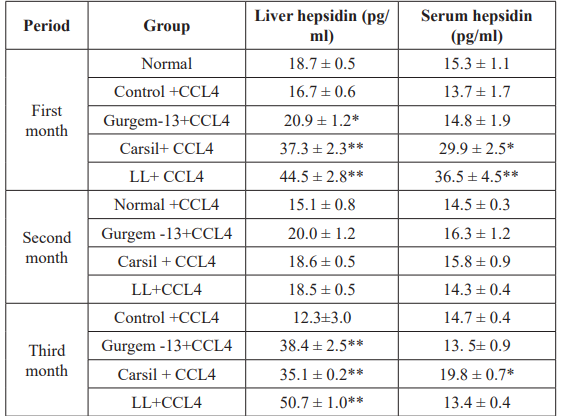
Table 7: The effect of Gurgem-13 on hepsidin in CCL14 induced chronic hepatitis. Note: *p=0.05, **p=0.00.
Liver hepcidin protein has increased 2.1 times in the first month, 34% in the second month, and 3.1 times in the third month, Carsil group 2.2 times, 23.2% and 2.8 times, in Lilycoagulant group 2.5 times in the first month and 22.5 in the second month,4.1 times in third month (p = 0.05). Serum hepcidin in the groups treated by Gurgem-13 and Carsil. Lilicoagulant, has increased by 8% and 2.2-4.1 times compared to the control group in first month, but was decreased by 12.4% only in Gurgem-13 group in second month and 35% in Carsil group in the third month (p=0.05). Hepsidin levels decrease in hepatitis due to hepcidin synthesis and secretion by the liver is controlled by iron stores within inflammation of the liver.
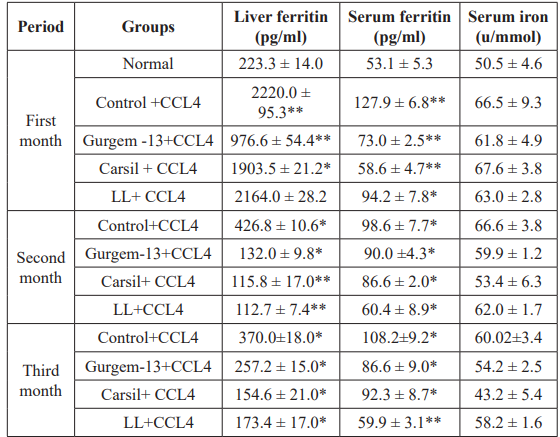
Table 8: The effect of Gurgem-13 on iron metabolism in CCL14 induced chronic hepatitis. Note: *p=0.05, **p=0.00.
Serum ferittin level in Gurgem-13 treated group has decreased by 43%, 8.7%, 20%, Carsil-treated group 54.1%, 9.4%, 29%, Lilicoaguliant-treated group 26.3%, 39%, 44.6%. Those result shows statistically significant (p=0.05).
Iron levels in serum of pathology induced experimental model in control group was increased than normal group, also those who used Gurgem 13 reduced this high iron level in 1-3 months respectively. In other words, iron level was decreased by 7.1%, 11.1% and 9.7% in three months compared to the control group. Comparison traditional remedy Carsil has reduced free-iron level by 20-28% in 2-3 months, while Lilicoaguliant had no impact on iron level.
Discussion
We selected CCL4-induced chronic hepatic model, and AST and ALT enzymes were dramatically increased during following three months. it shows that process of hepatocellular necrosis and breakdown were occurred intensively. In addition, while we measured albumin as liver’s protein synthesis, decreased albumin level by 13,3 - 33% in the first three months showing that structural and functional abnormalities of liver were occurred. These results indicate that chronic hepatic model was successfully induced by CCL4 in experimental animals.
Serum hepcidin in the groups treated by Gurgem-13 and Carsil. Lilicoaguliant, has increased by 8% and 2.2-4.1 times compared to the control group in the first month, but it decreased by 12.4% only in the Gurgem-13 group in the second month, and 35% in Carsil group in the third month (p=0.05). This result represents chronic hepatitis associated with liver synthesized hepcidin protein which is regulate iron metabolism in body is likely to decreased in chronic hepatitis than normal levels but hepcidin level was increased by regulation of Gurgem-13’s hepatoprotective effect [6-10]. In order to determine how iron metabolism behaves inside laboratory animals with artificially induced poisoning during chronic hepatitis, we compared their serum iron, liver tissue, serum hepcidin, ferritin level to a healthy group View of result, liver tissue and the serum hepcidin protein’s level in control groups tends to reduce during whole of experimental period. Ferritin which is stores iron in human body decreased in chronic hepatitis model, ferritin level was decreased by 56.01% in the Gurgem-13-treated group, 15% in the Carsil-treated group, weren’t show statistically significant difference in the Lilicoaguliant-treated group, at second month the Gurgem-13- treated group has decrease ferritin level by 69%, the Carsil-treated group has decrease it by 73%, the Lilicoaguliant-treated group has decrease it by 73.6%, at third month those groups respectively decrease it by 30.5%, 58.2%, 53.1%.
In the study of D.Badamsuren (2009) et.al, the Gurgem reduced alkaline phosphatase, glutamine-pyruvate transaminase and lactat dehydrogenase enzyme levels during toxic hepatitis, also prevented cirrhosis, and shown anti-inflamatory effect on liver [11], it may be caused by to support regeneration of hepatic cells by reducing hepatic cytolysis. Lin YI, Huang YT (2007) et.al they found that Gurgem has been reducing hepatic cytolysis [6]. Carnation contains oleic and crategolic acid which has anti- inflammatory effect by boosting defensive ability of leucocytes and activating liver’s detoxing glutation S-Transpherase enzyme. Ruta contains ether oil and lactone is mainly used to activate circulation of white blood cell, suppression of inflammation, and neutralize free radicals. Terminalia Chebula contains 20-40% of fiber compounds, main ingredient such as ellagic acid, galloyl, luteolin, tannic acid, sennosides A etc and resins, those mainly used for biological activity that lowers blood’s glucose level, anti-viral and hepatoprotective effect [7], Gardenia jasminoides has pharmologic activity of antioxidant [9], also prevents from CCL4 induced chronic cirrhosis. Pterocarpus marsupium contains catechin type of compounds which has anti-inflammation effect, protect mucosa layer of the gastrointestinal tract, strengthen blood vessels and stops bleeding.
In conclusion, biological active components of Gurgem-13 reduce cytolysis and cholistatistic and regulate iron metabolism which shows hepatoprotective effect in CCL4 induced chronic hepatitis.
Conclusion
- Laboratory rats with CCL4 induced chronic hepatitis during experimental 3 months period had shown drastically elevation on AST, ALT enzymes leading to enormous cytolysis, and reduction of 3-33% protein production and decreased liver synthesis.
- Gurgem-13 compound had effect on decreasing the cholestatis and toxic metabolitic oxidate from fatty acid as regulating iron metabolism and liver synthesis by decreasing AST, ALT and hepcidin, (p≤0.05) level to normal range.
References
- Foster, Steven, Yue, et Herbal emissaries: bringing Chinese herbs to the West: a Guide to Gardening, Herbal Wisdom, and Well-Being. Healing Arts Press. 1992; 185.
- Ligaa Mongolian traditional medicine and pharmaceutical herbsp. Ulaanbaatar, Mongolia : JKC printing. 2005; 181-182.
- An Atlas of Traditional Mongolian Medicinal Ingredients on Exhibit. Beejin. 2007.
- Da-Hee Jeong, Gi-Ppeum Lee, Won-Il Jeong, et Alterations of mast cells and TGF-1 on the silymarin treatmentfor CCl4- induced hepatic fibrosis. World J Gastroenterol. 2005; 11: 1141-1148.
- Davgatseren B. Mongolian and Tibet traditional medicine of Ulaanbaatar, Mongolia; 1996; 129-151.
- Fan L, Zhao HY, Xu M, et al. Qualitative evaluation and quantitative determination of 10 major active components in Carthamus tinctorius by highperformance liquid chromatography coupled with diode array detector. Journal of Chromatography A. 2009; 1216: 2063-2070.
- Anwesa Bag, Subir Kumar Bhattacharyya, Rabi Ranjan The development of Terminalia chebula Retz. (Combretaceae) in clinical research. Asian Pacific Journal of Tropical Biomedicine. 2013; 3: 244-252.
- Ando I, Tsukumo Y, Wakabayashi T, et Safflower polysaccharides activate the transcription factor NF-kappa B via Toll-like receptor 4 and induce cytokine production by macrophages. Internat Immunopharmacol. 2002; 2: 1155- 1162.
- Gilman, University of Florida: Insititute of food and agricultural sciences 1999.
- Stefan Mauss, Thomas Berg, Juergen Rockstroh, et Hepatology. 2009
- Elliott Middleton Jr. Biological Properties of Plant flavonoids; International Journal of 2001; 39: 26-29.